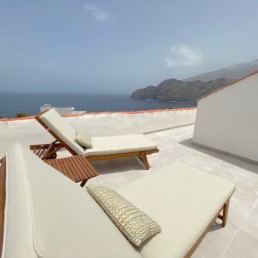An extreme territory with a mild weather
Few places in the world can boast La Gomera’s natural beauty and variety. The island contains a wealth of ecological treasures whose value is further increased by the fact that many date back to prehistoric times. Steep and rugged, the island of La Gomera consists of a high, relatively flat area in the centre, the central plateau, with an undulating landscape that descends to around 800 metre mark.
A series of ravines, extremely deep in the north and relatively flat in the south (las lomadas) spread out from the central plain to the shores of the Atlantic. At their lowest points, these ravines sometimes open out into verdant valleys, and where they meet the ocean, they form magnificient beaches which alternate with the sheer cliffs that line the La Gomera coastline.
The Terrain
An old and worn-out island
To know the landscape of La Gomera is essencial to understand the history of it’s inhabitants. The rough and steep terrain has marked the society, and it’s the key to know the misterious past of the island.
La Gomera is the only island on the archipelago on which no volcanic eruptions have taken place in modern times. In fact, the island has been free from volcanic activity for over two million years. In consequence, erosion has been more continuous, giving us the sheer cliffs, spectacular rocks and deep ravines that are such an essential part of the island’s landscape.

Wildlife
Animals in the islands are small, shy and largely undetected by the untrained eye. Bugs abond, and lizards and birds are the biggest things you’ll see. There are around 200 species of birds on the islands, though many are imports from Africa and Europe.
The Ocean is home to a more thrilling wildlife. The stretch of water between Tenerife and La Gomera is a traditional feeding ground for as many as 26 species of whales and cetaceans, and others pass through during migration. The most common are pilot whales, sperm whales and bottlenose dolphins. Furthermore, in the Canary Islands are 350 species of fishes and 600 of weeds. You can see them personally on one of the Sustainable Whalewatching Tours of La Gomera.
Diving and snorkel can be quite an interesting experience, but much more due to the caves and rocky landscapes than to the colourful marine life.
Plants
The island of La Gomera has 16 protected areas, not including the Garajonay National Park. Laurisilva or laurel forest is a typical plant formation that covered a large part of the Mediterranean basin during the Tertiary Era, millions of years ago. These forests were later relegated to warmer, more southerly regions by the glaciers that reigned in the north during the Quaternary Era. Today, they survive only in the Canary Islands, Madeira and the Azores, being most abundant in the Garajonay National Park on La Gomera.
The island’s landscape has more than 115,000 Canary Island Date Palm (phoenix canariensis). Although a few isolated specimens can also be found, it is in the vast palm groves such as the one at Taso that the species can be appreciated in its full glory. Date palms are tapped for guarapo or palm sap, which is then used for making palm syrup.
The weather on La Gomera by month
Average max. and min. daily temperatures and average rain.






